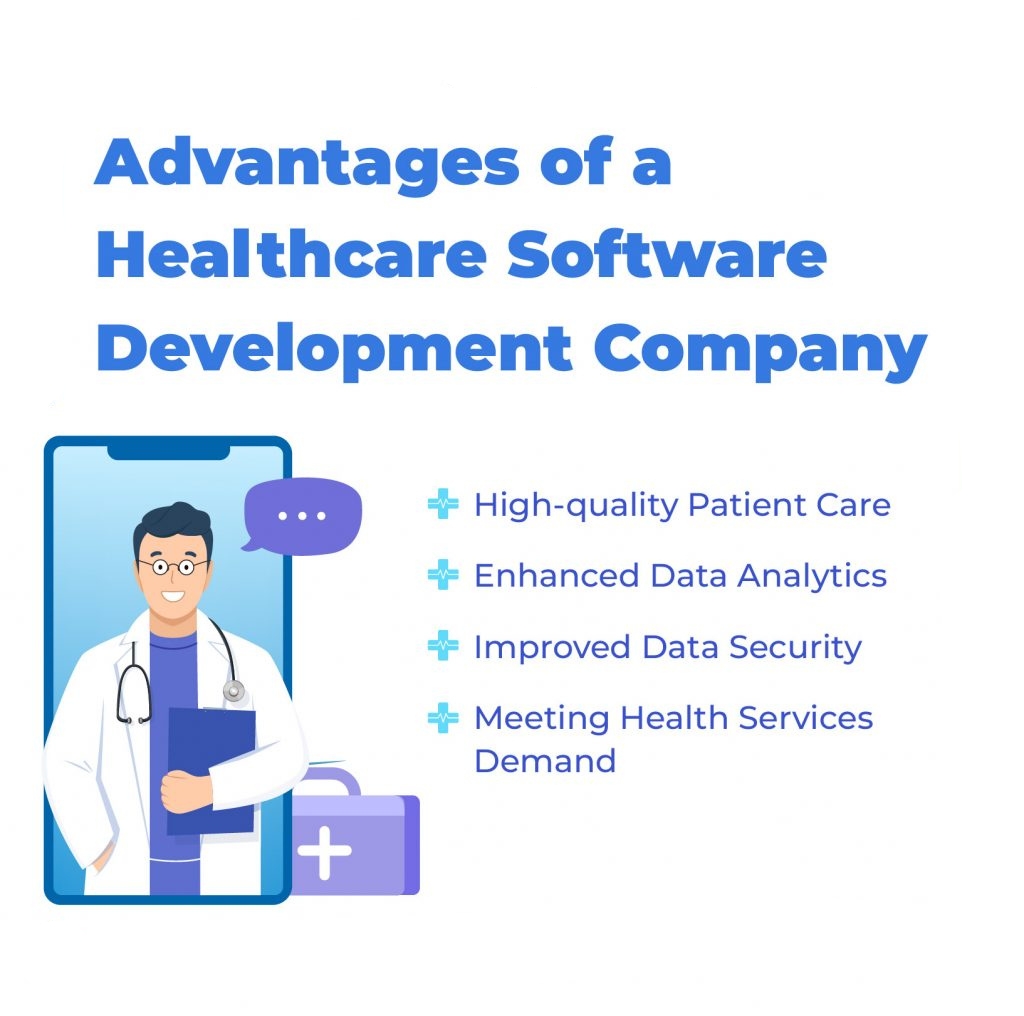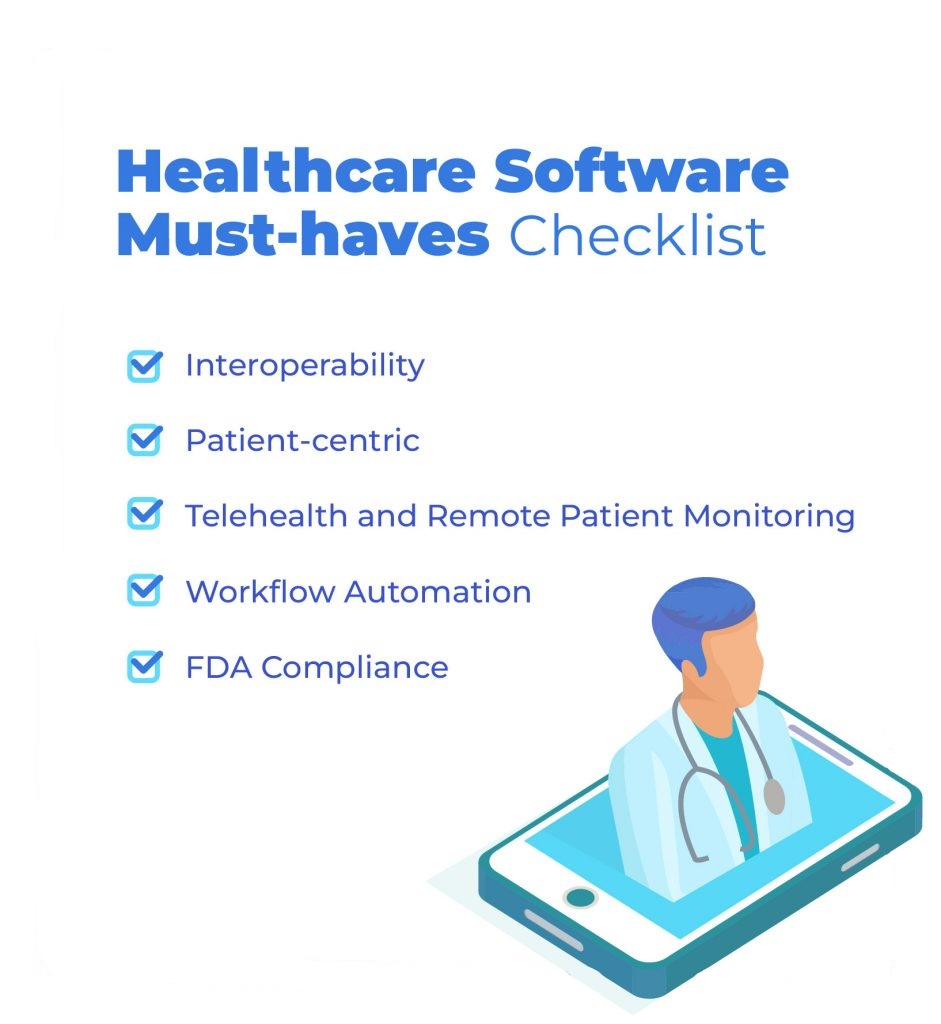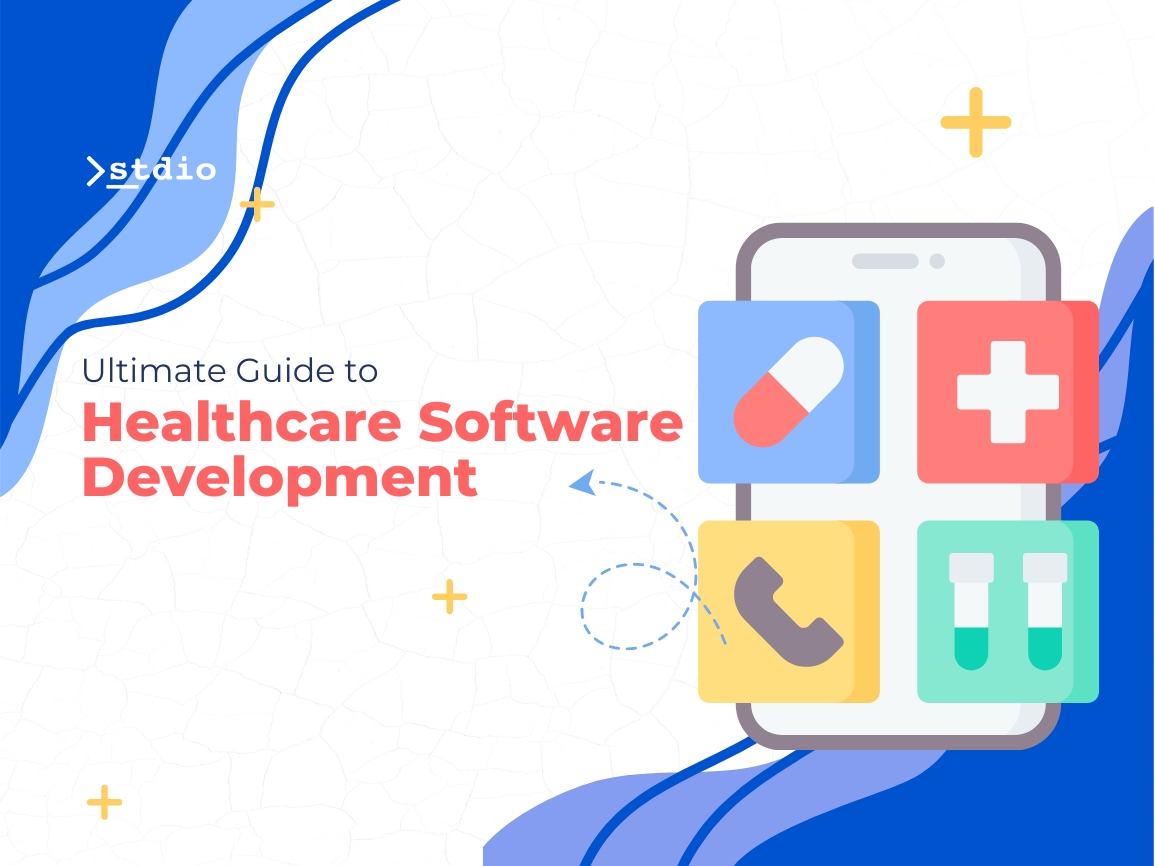In 2023, the Healthcare Software Development market is experiencing unprecedented prosperity. Companies, developers, and their services in this industry are thriving, as predicted by late-year trends.
The healthcare software industry is booming, with a new app created daily and an estimated annual revenue of $579.40 billion. To succeed in this competitive field, companies must strive to be the best. In this blog, we provide a guide to developing successful healthcare software, covering advantages, trends, must-haves, and steps. Initially, healthcare software focused on managing patient information, but it has evolved to include communication and information sharing, decision-making tools, remote monitoring, predictive modeling, image analysis, and more. Today, healthcare software is used for interoperability, population health management, medication management, patient engagement, education, mobile health, and more. The goal is to enhance healthcare delivery, improve patient outcomes, streamline administrative processes, and enable data-driven decision-making.
What is Healthcare Software Development?
Before proceeding, it is important to clarify that healthcare software development pertains to the creation, design, and implementation of software solutions specifically tailored for the healthcare industry. The objective of these activities is to address issues that arise between caregivers, patients, and organizations within the sector.
The development of software for healthcare services involves the utilization of various programming languages, frameworks, and technological tools to construct applications, platforms, or systems that cater to the unique challenges faced by healthcare providers and patients. These solutions work together to create an ecosystem that enhances the quality and accuracy of healthcare services provided by companies in the industry.
Software services in the healthcare industry can be identified in various forms, such as clinical resources, medical equipment, or even financing management devices. The ultimate goal of all technological advancements in this field is to leverage technology to improve healthcare delivery and contribute to better health outcomes.

Benefits of a Healthcare Software Development Firm
The rise of healthcare software development agencies was not unexpected. The growing need for specialized tech solutions has made the healthcare industry realize the advantages of incorporating IT. A skilled team of healthcare software developers can offer benefits such as improved data analysis, enhanced data security, and high-quality patient care. Additionally, with the right tech tools, healthcare professionals are better equipped to meet the increasing demand for medical services.
High-quality Patient Care
Healthcare is being transformed by software, revolutionizing the way services are provided. Today, scheduling appointments and documenting information can all be done through software.
Companies and agencies in healthcare software development utilize personalized software to access patient records, monitor medical histories, handle medications, coordinate care, and perform other tasks that enhance the quality of care for patients.
By incorporating software development, healthcare resources are utilized more efficiently, wait times are reduced, and patient satisfaction is improved.
Improved Data Analysis
The work of healthcare software developers enables medical professionals to utilize advanced data analytic techniques, providing them with valuable insights into the health status of their patients. These processes can be applied to a vast amount of information, allowing for the identification of patterns and outliers. Consequently, the gathered data equips specialists with enhanced clinical decision support, enabling proactive healthcare interventions.
Enhanced Data Protection
Healthcare software development companies possess the necessary tools to address the critical data security and privacy requirements of the sector. In fact, most developers incorporate strong security measures to safeguard data from unauthorized access or breaches. Examples of these security measures include encryption, access controls, and secure authentication protocols.
The volume of information managed, stored, transmitted, and retrieved by medical clinics continues to reach unprecedented levels. Enterprises are well aware of this situation and therefore promote the adoption of security practices to protect the data.
In addition, healthcare software developers choose to integrate compliance with regulations such as HIPAA and GDPR into the software development process. This ensures the confidentiality and integrity of medical information.
Addressing the Need for Health Services
Healthcare remains an essential societal requirement that is unlikely to cease in importance. Upon careful consideration, its significance has increasingly become apparent in recent years. The industry’s need for more effective solutions was highlighted during the pandemic.
Software development facilitates the expansion of healthcare’s reach and enables it to meet the ever-growing demand. For instance, telehealth solutions, remote patient monitoring tools, and mobile health apps empower providers to deliver care from a distance. These tools are also suitable for reaching underserved populations and optimizing the allocation of resources.
Healthcare Software Development: Types
Healthcare software development companies typically fulfill essential requirements, but also offer a variety of features and functionalities tailored to specific industry needs. In this article, we will explore the most in-demand types of healthcare software development services for agencies.

Urgent Care
The utilization of healthcare software has become a prevalent initiative among developers due to its ability to facilitate urgent care clinic operations and provide a multitude of benefits compared to conventional methods. This healthcare application enables patients to receive emergency assistance without physically visiting a doctor’s office.
It encompasses various features, including appointment scheduling, patient triage, EMR management, billing, and integration with laboratory and diagnostic systems. Specialized software is essential for urgent care facilities to ensure efficient patient flow management, timely care delivery, and optimal attention provision.
Healthcare CRM
Healthcare software developers create software tools that enable better patient relationship management, contact management, improved care quality, and more accurate performance reports. Customer Relationship Management (CRM) has been used in the IT industry for a long time to manage interactions and relationships with potential and existing customers.
The healthcare industry has also adopted these systems to enhance patient engagement and relationship management. CRM enables healthcare providers to centralize patient interactions, track preferences, manage referrals, and provide personalized patient experiences. Additionally, healthcare software developers can integrate other applications such as EHRs and scheduling systems to provide a comprehensive view of patient interactions.
EHR – Electronic Health Record Software
With this type of healthcare software development, companies can digitally store, manage, and exchange patient medical records. EHR software has replaced traditional paper-based health records, enabling healthcare professionals to oversee patients’ information through technology. Additionally, these systems offer clinicians a comprehensive view of a patient’s medical history, including medications, diagnoses, lab results, and treatment plans.
The implementation of EHRs has significantly improved the quality of care by providing healthcare professionals with a complete understanding of their patients’ situations. Moreover, these solutions effectively minimize medical errors by granting health professionals access to vital information from any location.
Hospital Management System
This tool is ideal for healthcare software development agencies as it enables them to efficiently manage multiple tasks and departments, ensuring the smooth operation of hospitals. The software optimizes administrative processes, streamlines workflows, and enhances the productivity of executive teams. Users of hospital management software attest to its comprehensive solution, covering patient registration, appointment scheduling, billing and invoicing, inventory management, pharmacy management, electronic medical records, and reporting. Healthcare software developers assert that the software’s functionality is easy to comprehend, as it collects data from various sources and processes it with algorithms to generate analytics that enable staff to improve quality and make cost-reducing decisions.
Software For Managing Medical Practices
MPM simplifies hospital operations by automating administrative and financial tasks such as appointment scheduling, patient registration, billing, invoicing, insurance claims management, and reporting. This allows healthcare software development companies to prioritize patient care.
E-prescribing Software
Healthcare software developers have created a tool that generates and transmits prescriptions electronically, replacing the traditional paper-based ones. This approach is more efficient, allowing healthcare providers to share prescriptions with pharmacies digitally. It also reduces errors and improves patient safety. E-prescribing software enables pharmacists to track medication history without contacting the physician, optimizing the entire process. All of this is made possible by healthcare software development agencies.
Healthcare Software: Emerging Tech
Up-and-coming healthcare software development companies must embrace and leverage emerging technologies to position themselves as industry leaders. Likewise, every enterprise seeks to deliver innovative solutions and contribute to medical delivery advancement. Keeping up with the latest trends is the way to go for healthcare software development agencies.
Incorporating technologies like AI, machine learning, and blockchain enables firms to meet healthcare organizations’ evolving needs, improve patient care outcomes, and create a strong foothold in the competitive healthcare software market.
AI – Artificial intelligence
AI is revolutionizing healthcare software development with its advanced capabilities. It greatly improves medical image analysis by accurately identifying patterns and abnormalities, assisting radiologists in diagnosing conditions like tumors and fractures. This leads to faster and more precise diagnoses, benefiting patients. Additionally, AI-powered clinical decision support systems analyze patient data and medical literature to provide evidence-based recommendations. Lastly, Natural Language Processing (NLP) allows computers to understand and interpret human language, enabling algorithms to transcribe medical dictation, extract information from clinical notes, and facilitate voice recognition in healthcare software.
ML – Machine Learning
Machine learning is a subset of AI that has greatly advanced healthcare software development. Its focus is on enabling computer systems to learn from data and make predictions or decisions without explicit programming. Machine learning is revolutionizing healthcare software development agencies through predictive analytics, personalized medicine, and operational optimization.
Predictive analytics allows software to identify high-risk patients, enable early intervention, and optimize treatment plans. Machine learning algorithms can also develop personalized treatment plans by tailoring interventions to patients’ unique characteristics. Additionally, they can predict patient demand, streamline resource allocation, and optimize scheduling processes.
Blockchain
Blockchain technology is the latest advancement in healthcare software development that is widely known for its ability to securely manage and share data. By integrating blockchain into clinical devices, developers can enhance the security, privacy, interoperability, and exchange of health information.
Blockchain ensures that healthcare data is stored and exchanged in a secure and tamper-proof manner. It utilizes cryptographic techniques to safeguard patient data from unauthorized access and manipulation.
Companies involved in healthcare software development that adopt blockchain technology can seamlessly share health information across different healthcare systems and providers. This is made possible by eliminating the need for intermediaries, simplifying administrative processes, and ensuring the integrity of data.
Healthcare Software Must-haves
If you’re new to the game, it’s recommended to take some notes on the top healthcare software solutions. These solutions typically include interoperability, patient-centric features, telehealth/remote monitoring, workflow automation, and regulatory compliance.

Improving Interoperability
The seamless exchange and utilization of data across various platforms and settings is what interoperability entails for healthcare software companies and applications. This feature ensures the secure and efficient sharing of patient information among healthcare providers. Interoperability not only enhances care coordination and minimizes errors but also enables healthcare software developers to integrate their projects with other systems such as EHRs and medical devices. Platforms possessing this attribute have a higher likelihood of evading the duplication of tests and procedures, resulting in cost savings and enhanced delivery efficiency.
Patient-centric
Healthcare software companies that prioritize the patient experience aim to make the patient the focal point of care. By involving patients in their care decisions and providing them with access to their health data and tools, patient-centric projects enhance patient satisfaction.
This approach also enables personalized medicine by tailoring treatments and interventions to meet the unique needs and preferences of each patient. Additionally, this mindset promotes collaboration between patients and healthcare providers, fostering a strong partnership and shared decision-making.
RPM Remote Patient Monitoring and Telehealth
Telehealth and remote monitoring have become essential to healthcare software development companies, especially during the pandemic. They enable virtual consultations, providing patients with remote access to healthcare services. This is particularly important for those in remote or underserved areas. Additionally, these technologies allow for continuous monitoring of patients’ vital signs and recovery progress, promoting early intervention and timely care.
Automating Workflows
Workflow automation in healthcare streamlines manual and repetitive tasks, alleviating administrative burdens. This allows healthcare providers to prioritize patient care and reduces the time spent on administrative duties. Moreover, it promotes better coordination among medical teams, ensuring timely access to crucial information.
FDA Compliance
All healthcare-related products must pay close attention to this one, as its omission will most likely bring enterprises into big trouble. The FDA regulates the safety of all medical products prior to their appearance in the market. It is crucial for healthcare software involving medical devices, diagnostics, or any functionality under regulatory oversight.
Compliance with FDA regulations enhances trust among healthcare providers and patients; it signifies that products meet rigorous standards for quality and safety. Healthcare software development companies must work on carefully navigating the regulatory landscape to avoid any legal or reputational risks.
How to Develop Healthcare Software?
To develop successful healthcare software, you need a well-defined and systematic approach. Follow these steps to navigate the development process effectively:
- Planning: Define the problem and scope of your software.
- Analysis: Conduct market research and analyze user needs.
- Design: Create user-friendly interfaces and user experiences.
- Development: Build your software according to your plan and design.
- Testing: Conduct thorough quality assurance testing to ensure that your software is working properly.
- Deployment: Launch your software and make it available to users.
- Maintenance: Provide ongoing support and updates to your software.
Now, let’s get started!
Planning: Problem Definition and Scope
During the planning phase, it is essential for your agency to define the problem you want to solve and the scope of the healthcare software. Consider the following actions:
- Identify the specific healthcare challenge or need your software will address. This could include streamlining patient data management or improving medication adherence. It is important to have a clear understanding of this before proceeding with the project.
- Determine the scope of your software by outlining its features, functionalities, and target audience. Take into account factors such as scalability, integration with existing systems, and regulatory requirements.
- Set clear goals and objectives for your healthcare software development company. These could include enhancing patient outcomes, improving operational efficiency, or increasing patient engagement.
Market Research Analysis
Healthcare software developers need to understand the industry, user requirements, and potential rivals.
- Conduct an investigation on the existing healthcare software solutions available in the market. Analyze their advantages, disadvantages, and areas of improvement that your software can cater to.
- Conduct surveys, interviews, or focus groups with healthcare professionals and potential end-users to gather requirements and understand pain points.
- Learn the regulatory requirements and compliance standards for healthcare software, including the FDA and HIPAA.
Designing: UI/UE
Serious healthcare software developers always value design as it is crucial in developing a user-friendly and intuitive healthcare software solution. Here are some recommended actions to consider:
- Create user personas by understanding your target audience’s needs, preferences, and challenges. Our software is tailored to meet their specific requirements.
- Visualize the software’s layout, navigation, and interactions using wireframes or prototypes. Adjust the designs based on feedback and usability testing.
- Make sure the user interface design is attractive, easy to use, and accessible to everyone.
- Collaborate with healthcare professionals and UX designers to create workflows that align with clinical processes, enhancing user efficiency.
Developing Software for Healthcare: Let’s Get to Work
After completing the necessary planning, analysis, and design, we can now proceed with developing your application.
- Choose the suitable technology stack and development tools that match your software requirements and scalability needs.
- Divide the development process into smaller tasks or sprints. Set up a timeline and milestones for the development.
- Ensure your code is both clean and efficient by adhering to coding best practices and implementing features and functionalities that align with the defined scope.
- Integrate essential APIs or third-party services that enhance the value of your healthcare software. Experiment with EHRs or medical device interfaces.
- Code documentation and version control are essential for collaboration among developers and future maintenance.
Testing: Healthcare software development undergoes quality assurance
Ensure your healthcare software functions properly, is secure, and offers a smooth user experience through testing.
- Conduct functional testing to ensure all features and functionalities are working correctly. Test various user scenarios and edge cases to detect and resolve any problems.
- Healthcare software developers must guarantee a uniform user experience by conducting compatibility testing on different devices, operating systems, and web browsers.
- Implement rigorous security testing. This will help you identify vulnerabilities and ensure compliance with data protection regulations.
- Test the software’s usability with representative users and collect their feedback on its intuitiveness, ease of use, and performance. Use the findings to make any necessary improvements.
Deploy: Start the Software
After testing, a healthcare software development agency can get ready for the launch and deployment of the software.
- Developers of healthcare software will set up the required infrastructure, including servers and databases, to host the software.
- Conduct a final round of testing to ensure proper functioning of all components and readiness of the software for production use.
- Create user accounts, assign roles and permissions, and ensure software security measures are implemented.
- Make sure authorized users can access the software by deploying it to the target environment.
Maintaining: Ongoing Support and Updates
Even after the software is deployed, ongoing support and maintenance are crucial for the long-term success of your healthcare software development company.
- Provide immediate technical assistance to handle user questions, problems, and suggestions.
- Continuously monitor the performance of the software and apply necessary updates, patches, and bug fixes.
- Stay updated on any regulatory changes and updates that could impact your software. Make necessary updates accordingly.
- Regularly collecting feedback from users helps to identify areas for improvement and discover new features that can enhance the software’s functionality and user experience.
In summary
Congratulations to all healthcare software development companies striving to improve medical services. Our tips, trends, and information will aid your development process. Keep clear goals in mind to navigate the road ahead. With dedication and hard work, you can create a valuable service that positively impacts patient care and healthcare outcomes. Contact STDIO to bring your dream healthcare software development service to life.



Leave a Reply